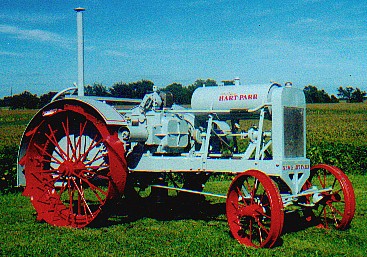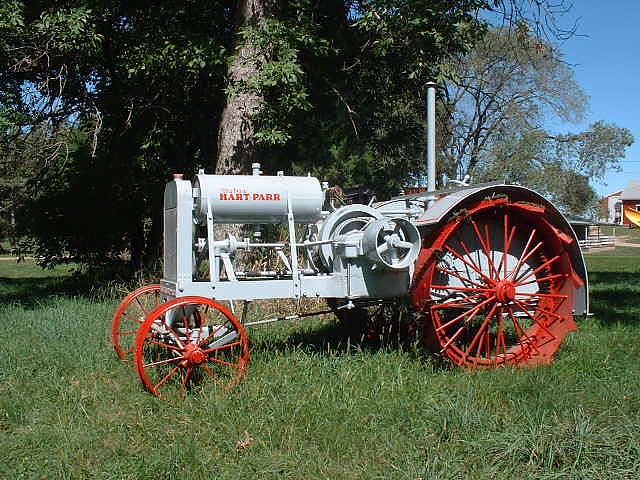 At that point the familiar dark green paint was used and the red wheels continued. This color combination
remained until the end of production on the lightweight tractors in 1930. Many little things are different
on these tractors. The most obvious thing is the New Hart-Parr
cast into the front casting just below the radiator. Also the two holes in the front casting
were first made in a triangle shape and then they made them round and put the exhaust pipe out the front.
The first 300 tractors built used a short exhaust pipe with the muffler sticking straight down
under the engine. Some other distinct things that tell you right away that it is a New Hart-Parr
are the open flyball governor, a foot brake instead of a hand brake (although some later tractors
built in 1919 had a hand brake), see foot brake here, a flat bottom Madison Kipp lubricator was used and was mounted
on cast iron pedestals. Some of the unique things used on the 1918 New Hart-Parr
are the steering wheel, fuel tank, and front steering universal joints. These parts are hold over parts from
the Hart-Parr Little Devil tractor, according to part numbers.
At that point the familiar dark green paint was used and the red wheels continued. This color combination
remained until the end of production on the lightweight tractors in 1930. Many little things are different
on these tractors. The most obvious thing is the New Hart-Parr
cast into the front casting just below the radiator. Also the two holes in the front casting
were first made in a triangle shape and then they made them round and put the exhaust pipe out the front.
The first 300 tractors built used a short exhaust pipe with the muffler sticking straight down
under the engine. Some other distinct things that tell you right away that it is a New Hart-Parr
are the open flyball governor, a foot brake instead of a hand brake (although some later tractors
built in 1919 had a hand brake), see foot brake here, a flat bottom Madison Kipp lubricator was used and was mounted
on cast iron pedestals. Some of the unique things used on the 1918 New Hart-Parr
are the steering wheel, fuel tank, and front steering universal joints. These parts are hold over parts from
the Hart-Parr Little Devil tractor, according to part numbers.
 The early prototype tractor may have been labeled 12-25, but none of the
early advertisements make mention of the 12-25 horsepower rating. After several months of production the horsepower rating was labeled as 15-30, referring
to 15 horsepower on the drawbar and 30 horsepower on the belt pulley.
Another very distinct internal difference on the New Hart-Parr is the heavy counterweights bolted
to the crankshaft. After approximately building 1000 tractors the design was changed by adding an external
counterweight fitted onto the outside end of the crankshaft, this design carried through all the models to 1930. I'm sure some of these bolted on counterweights came loose
and demolished the engine. These counterweights can be seen
The early prototype tractor may have been labeled 12-25, but none of the
early advertisements make mention of the 12-25 horsepower rating. After several months of production the horsepower rating was labeled as 15-30, referring
to 15 horsepower on the drawbar and 30 horsepower on the belt pulley.
Another very distinct internal difference on the New Hart-Parr is the heavy counterweights bolted
to the crankshaft. After approximately building 1000 tractors the design was changed by adding an external
counterweight fitted onto the outside end of the crankshaft, this design carried through all the models to 1930. I'm sure some of these bolted on counterweights came loose
and demolished the engine. These counterweights can be seen